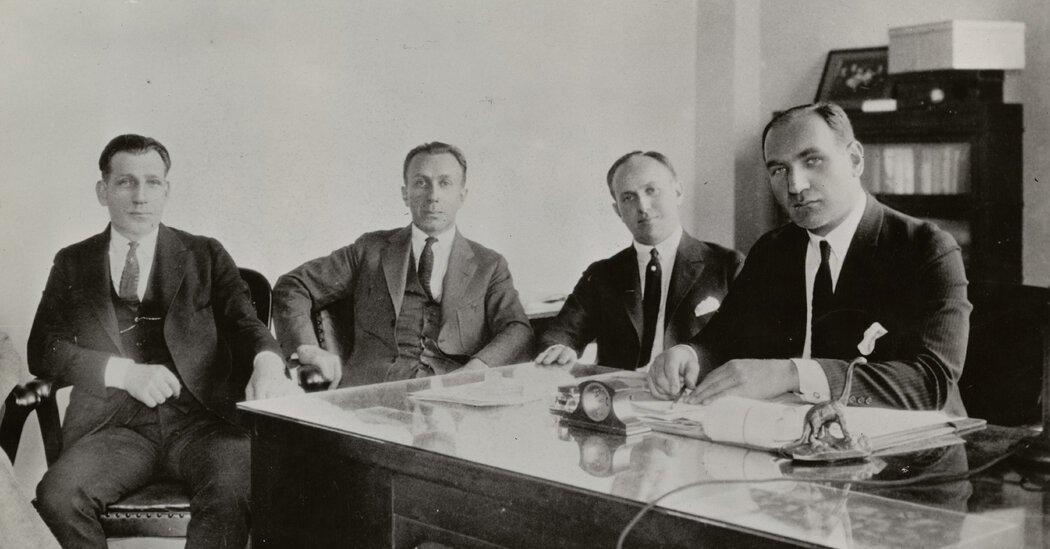The Jews who founded Hollywood — and make no mistake, the big studio heads were overwhelmingly Jewish — shared several things: ambition, creative vision and killer business instincts.
But more than anything else, the men who were the driving forces behind Paramount, 20th Century Fox, Warner Brothers, Universal, Columbia and Metro-Goldwyn-Mayer shared a very 20th-century sense of being Jewish in America. They were assimilationists who considered themselves American above all else and who molded Hollywood to reflect and shape their American ideals.
“Above all things, they wanted to be regarded as Americans, not Jews,” Neal Gabler wrote in his definitive 1988 history, “An Empire of Their Own: How the Jews Invented Hollywood.” Louis B. Mayer, a co-founder of MGM, went so far as to claim that his birth papers had been lost during immigration and to declare his birthday henceforth as the Fourth of July.
It was troubling, then, that when the Academy Museum of Motion Pictures opened in 2021, it neglected to integrate Jews into its portrayal of Hollywood’s early days and later successes despite obvious attentiveness to other ethnic and racial groups. Beyond a few brief mentions, including Billy Wilder fleeing Nazi Germany, a photo of the MGM mogul and academy founder Louis B. Mayer looming over Judy Garland, and a few scoundrels in an exhibit on #MeToo, Jews were absent. Jewish studio heads, business leaders and actors were almost entirely shut out, an oversight that led to much outcry.
“It’s sort of like building a museum dedicated to Renaissance painting and ignoring the Italians,” the Hollywood historian and Brandeis University professor Thomas Doherty told Rolling Stone at the time.
When I asked the museum’s former director and president Bill Kramer, now the C.E.O. of the Academy of Motion Picture Arts and Sciences, what he made of the omission, he did not acknowledge the error but said museum officials took the criticism seriously. “It was clear that this was something that certain stakeholders were expecting,” he said. “That in some visitors’ minds this was an omission that needed to be corrected.” Did he think the criticism was valid? “It was how people felt. And those feelings were real and feelings are valid.”
The museum has compensated for its neglect by creating what it calls its first permanent exhibit, “Hollywoodland: Jewish Founders and the Making of a Movie Capital,” which opened on Sunday.
The exhibit has three components. The first provides a panoramic view of how the city of Los Angeles evolved to accommodate an influx of immigrants, including Jews, the development of the film industry and the needs of its diverse population, from the Oglala Lakota people to Chinese immigrants, reflected in archival footage and an interactive table map. The second part tracks the history of the city’s studios, and the third screens an original documentary, “From the Shtetl to the Studio: The Jewish Story of Hollywood.” The space is intimate but expansive in its vision and is well executed.
So how were Jews left out in the first place? Some sources told Rolling Stone after the opening that those who might have applied more pressure earlier, chose to lay low during the museum’s development. Some of this reticence surely emerged from the tenor of the moment, with its focus on racial representation and what Kramer referred to as “pro-social” causes — gay rights, women’s equality, the labor movement — which the museum details in a dedicated section and weaves in throughout.
It may also be attributable to an uneasy tension among Jews around their place in America — eager to be integrated, included and successful, while at the same time wary of possible exclusion or alternately, too much notice, inciting a backlash and reanimating underlying antisemitism. The recent outburst of antisemitism that we’ve witnessed on college campuses and in protests against Israel had long been stewing within academia and across cultural institutions.
Throughout the Academy Museum’s development, much of which occurred after the rise of campaigns like #OscarsSoWhite, officials made clear that it would emphasize diversity and inclusivity. The museum highlights nonwhite and other marginalized contributors to the industry to help remedy the industry’s long record of exclusion.
“I don’t think you open a cultural institution at this historical moment and not be reflective of a diversity of histories and perspectives,” Jacqueline Stewart, the museum’s current director and president, told me when I asked about the museum’s focus on representation. She pushed back on the criticism. “There were references to Jewish filmmakers from the very beginning,” she said, mentioning a clip of a Steven Spielberg Oscar acceptance speech. “That seems to get lost.”
But in bending over backward to highlight various identity groups at every point, the museum unintentionally leaves out part of what makes the movies such a unifying and essentially popular medium: the ability to transcend those differences. In a pluralistic, immigrant nation, Hollywood helped create a uniquely American culture that speaks to a broad audience. That’s part of what we call the magic of movies.
If nothing else, Hollywood is relentlessly evolving, perhaps now more than ever under the threat of A.I., increased economic pressures and consolidation. The Academy Museum, too, continues to change. Much of what I saw in the museum — which must be said is a marvel and a must-see for any film lover — had been switched out for new material since I first visited in June 2022. Elements in the core exhibit are in constant rotation, in part due to fragility of its artifacts, like costumes; in part to reflect the immensity of its collection; and in other cases, in a then overt effort to hit all the bases among competing interests.
If this flux is indicative of the Academy Museum’s stated intent to represent the changing priorities of American audiences, then it also holds the potential to move beyond this current moment, with its intentional and unintended divisiveness.

